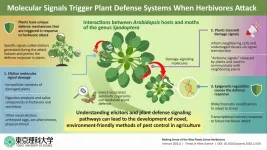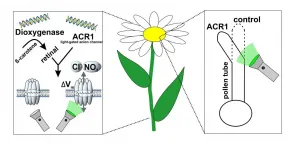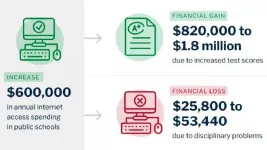(Press-News.org) Nature has its way of maintaining balance. This statement rightly holds true for plants that are eaten by herbivores--insects or even mammals. Interestingly, these plants do not just silently allow themselves to be consumed and destroyed; in fact, they have evolved a defense system to warn them of predator attacks and potentially even ward them off. The defense systems arise as a result of inner and outer cellular signaling in the plants, as well as ecological cues. Plants have developed several ways of sensing damage; a lot of these involve the sensing of various "elicitor" molecules produced by either the predator or the plants themselves and initiation of an "SOS signal" of sorts.
In a recently END
Perceiving predators: Understanding how plants 'sense' herbivore attack
How 'elicitors' can initiate defense responses in plants against herbivores, and can potentially lead to development of pesticide-free agriculture
2021-02-16
ELSE PRESS RELEASES FROM THIS DATE:
A boost for plant research
2021-02-16
It is almost ten years since the scientific journal Science called optogenetics the "breakthrough of the decade". Put simply, the technique makes it possible to control the electrical activity of cells with pulses of light. With its help, scientists can gain new insights into the functioning of nerve cells, for example, and thus better understand neurological and psychiatric diseases such as depression and schizophrenia.
Established procedure on animal cells
In research on animal cells, optogenetics is now an established technique used in many fields. The picture is different in plant research: transferring the principle to plant cells and applying it widely has not been possible until now.
However, this has now changed: Scientists ...
Individual differences in Achilles tendon shape can affect susceptibility to injury
2021-02-16
Individual variation in the shape and structure of the Achilles tendon may influence our susceptibility to injury later in life, says a study published today in eLife.
The findings suggest that studying individual Achilles tendon shape (or 'morphology') could help with identifying patients at risk of injury and designing new, potentially personalised approaches for treating and preventing Achilles tendinopathy and similar conditions.
The Achilles tendon is the tissue that links the calf muscles to the heel bone. It is fundamental to our movement and athletic ability. Its unique structure, which combines three smaller sub-tendons, increases the efficiency of our movement by allowing individual control from connected muscles. For this control to occur, the ...
The body produces new satiety factor during prolonged exercise
2021-02-16
A drug that helps us to eat less could help the more than 650 million people around the world who live with obesity. One of the emerging drug candidates that interest researchers is the hormone GDF15 that, when given to rodents, lowers their appetite and body weight. New research from the University of Copenhagen finds that the body produces large amounts GDF15 during extended bouts of vigorous exercise, presumably as a physiological stress signal.
This finding highlights central differences between GDF15 given as a drug (pharmacology), and GDF15 released naturally in response to vigorous exercise (physiology). This is an important distinction ...
Internet access spending in public schools increases test scores, but also disciplinary problems
2021-02-16
From 2015 to 2019, public school districts in the United States invested nearly $5 billion to upgrade their Wi-Fi networks, according to EducationSuperHighway. However, in the age of COVID-19-mandated virtual learning, millions of K-12 students still lack the minimal connectivity at home for digital learning.
In a new study from the University of Notre Dame, researchers quantify how school district connectivity increases test scores, but underscore the dark side of technology -- increased behavior problems.
A $600,000 increase in annual internet access spending produces a financial gain of approximately $820,000 to $1.8 million, alongside losses from disciplinary problems totaling $25,800 to $53,440, according to new research from Yixing Chen, an ...
Evidence shows how the human brain may tap into visual cues when lacking a sense of touch
2021-02-16
Researchers at the University of Chicago, the University of Birmingham, and Bournemouth University have uncovered evidence that physical embodiment can occur without the sense of touch, thanks to a study involving two participants who lack the ability to feel touch. The research was published on Feb. 12 in END ...
Quantum leaps in understanding how living corals survive
2021-02-16
Coral reefs have thrived for millions of years in their shallow ocean water environments due to their unique partnerships with the algae that live in their tissues. Corals provide a safe haven and carbon dioxide while their algal symbionts provide them with food and oxygen produced from photosynthesis. Using the corals Orbicella annularis and Orbicella faveolate in the southern Caribbean, researchers at the Carl R. Woese Institute for Genomic Biology (IGB) have improved our ability to visualize and track these symbiotic interactions in the face of globally warming sea surface temperatures and ...
Despite sea-level rise risks, migration to some threatened coastal areas may increase
2021-02-16
In coming decades as coastal communities around the world are expected to encounter sea-level rise, the general expectation has been that people's migration toward the coast will slow or reverse in many places.
However, new research co-authored by Princeton University shows that migration to the coast could actually accelerate in some places despite sea-level change, contradicting current assumptions.
The research, published in Environmental Research Letters, uses a more complex behavioral decision-making model to look at Bangladesh, whose coastal zone is at high risk. They found job opportunities are most abundant in coastal cities across Bangladesh, attracting more ...
The impact of COVID-19 on motherhood
2021-02-16
It's no secret that the risk related to the coronavirus (COVID-19) increases with age, making older adults more vulnerable than younger people.
Less examined has been effects on pregnancy and birthing. According to a new study led by Sarah DeYoung, assistant professor in the Department of Sociology and Criminal Justice, and Michaela Mangum, a master's student in disaster science and management, the pandemic causes additional stress for people who were pregnant or gave birth during the pandemic. The stress was especially prevalent if the person ...
Women have a lower range of 'normal' blood pressure than men
2021-02-16
A new study from the Smidt Heart Institute at Cedars-Sinai shows that women have a lower “normal” blood pressure range compared to men. The findings were published today in the peer-reviewed journal Circulation.Currently, established blood pressure guidelines state that women and men have the same normal healthy range of blood pressure. But the new research shows there are differences in normal blood pressure between the sexes.“Our latest findings suggest that this one-size-fits-all approach to considering blood pressure may be detrimental to a woman’s health,” ...
Study finds alligator hearts keep beating no matter what
2021-02-16
Mammals and cold-blooded alligators share a common four-chamber heart structure - unique among reptiles - but that's where the similarities end. Unlike humans and other mammals, whose hearts can fibrillate under stress, alligators have built-in antiarrhythmic protection. The findings from new research were reported Jan. 27 in the journal Integrative Organismal Biology.
"Alligator hearts don't fibrillate - no matter what we do. They're very resilient," said Flavio Fenton, a professor in the School of Physics at the Georgia Institute of Technology, researcher ...
LAST 30 PRESS RELEASES:
Early relapse predicts poor outcomes in aggressive blood cancer
American College of Lifestyle Medicine applauds two CMS models aligned with lifestyle medicine practice and reimbursement
Clinical trial finds cannabis use not a barrier to quitting nicotine vaping
Supplemental nutrition assistance program policies and food insecurity
Switching immune cells to “night mode” could limit damage after a heart attack, study suggests
URI-based Global RIghts Project report spotlights continued troubling trends in worldwide inhumane treatment
Neutrophils are less aggressive at night, explaining why nighttime heart attacks cause less damage than daytime events
Menopausal hormone therapy may not pose breast cancer risk for women with BRCA mutations
Mobile health tool may improve quality of life for adolescent and young adult breast cancer survivors
Acupuncture may help improve perceived breast cancer-related cognitive difficulties over usual care
Nerve block may reduce opioid use in infants undergoing cleft palate surgery
CRISPR primes goldenberry for fruit bowl fame
Mass General Brigham announces new AI company to accelerate clinical trial screening and patient recruitment
Fat tissue around the heart may contribute to greater heart injury after a heart attack
Jeonbuk National University researcher proposes a proposing a two-stage decision-making framework of lithium governance in Latin America
Chromatin accessibility maps reveal how stem cells drive myelodysplastic progression
Cartilaginous cells regulate growth and blood vessel formation in bones
Plant hormone allows lifelong control of proteins in living animal for first time
Swedish freshwater bacteria give new insights into bacterial evolution
Global measures consistently underestimate food insecurity; one in five who suffer from hunger may go uncounted
Hidden patterns of isolation and segregation found in all American cities
FDA drug trials exclude a widening slice of Americans
Sea reptile’s tooth shows that mosasaurs could live in freshwater
Pure bred: New stem cell medium only has canine components
Largest study of its kind highlights benefits – and risks – of plant-based diets in children
Synergistic effects of single-crystal HfB2 nanorods: Simultaneous enhancement of mechanical properties and ablation resistance
Mysterious X-ray variability of the strongly magnetized neutron star NGC 7793 P13
The key to increasing patients’ advance care medical planning may be automatic patient outreach
Palaeontology: Ancient tooth suggests ocean predator could hunt in rivers
Polar bears may be adapting to survive warmer climates, says study
[Press-News.org] Perceiving predators: Understanding how plants 'sense' herbivore attackHow 'elicitors' can initiate defense responses in plants against herbivores, and can potentially lead to development of pesticide-free agriculture




